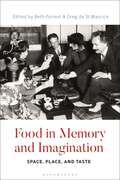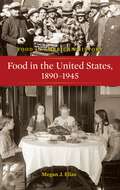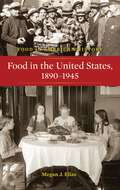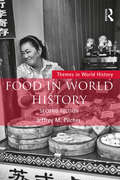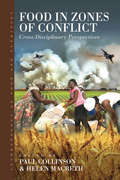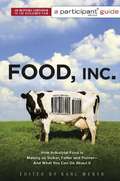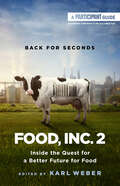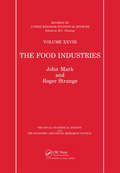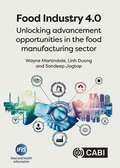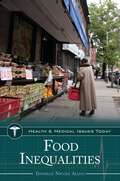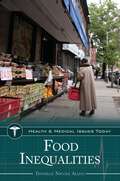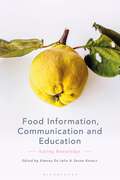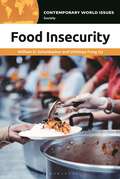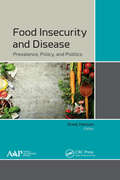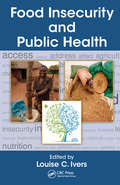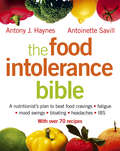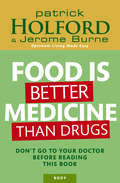- Table View
- List View
Food in Memory and Imagination: Space, Place and, Taste
by Beth Forrest Greg De St MauriceHow do we engage with food through memory and imagination? This expansive volume spans time and space to illustrate how, through food, people have engaged with the past, the future, and their alternative presents.Beth M. Forrest and Greg de St. Maurice have brought together first-class contributions, from both established and up-and-coming scholars, to consider how imagination and memory intertwine and sometimes diverge. Chapters draw on cases around the world-including Iran, Italy, Japan, Kenya, and the US-and include topics such as national identity, food insecurity, and the phenomenon of knowledge. Contributions represent a range of disciplines, including anthropology, history, philosophy, psychology, and sociology. This volume is a veritable feast for the contemporary food studies scholar.
Food in the United States, 1890-1945 (Food in American History)
by Megan J. EliasNo American history or food collection is complete without this lively insight into the radical changes in daily life from the Gilded Age to World War II, as reflected in foodways.From the Gilded Age to the end of World War II, what, where, when, and how Americans ate all changed radically. Migration to urban areas took people away from their personal connection to food sources. Immigration, primarily from Europe, and political influence of the Caribbean, Latin America, and the Pacific brought us new ingredients, cuisines, and foodways. Technological breakthroughs engendered the widespread availability of refrigeration, as well as faster cooking times. The invention of the automobile augured the introduction of "road food," and the growth of commercial transportation meant that a wider assortment of foods was available year round. Major food crises occurred during the Depression and two world wars. Food in the United States, 1890-1945 documents these changes, taking students and general readers through the period to explain what our foodways say about our society. This intriguing narrative is enlivened with numerous period anecdotes that bring America history alive through food history.
Food in the United States, 1890-1945 (Food in American History)
by Megan J. EliasNo American history or food collection is complete without this lively insight into the radical changes in daily life from the Gilded Age to World War II, as reflected in foodways.From the Gilded Age to the end of World War II, what, where, when, and how Americans ate all changed radically. Migration to urban areas took people away from their personal connection to food sources. Immigration, primarily from Europe, and political influence of the Caribbean, Latin America, and the Pacific brought us new ingredients, cuisines, and foodways. Technological breakthroughs engendered the widespread availability of refrigeration, as well as faster cooking times. The invention of the automobile augured the introduction of "road food," and the growth of commercial transportation meant that a wider assortment of foods was available year round. Major food crises occurred during the Depression and two world wars. Food in the United States, 1890-1945 documents these changes, taking students and general readers through the period to explain what our foodways say about our society. This intriguing narrative is enlivened with numerous period anecdotes that bring America history alive through food history.
Food in World History (Themes in World History)
by Jeffrey M. PilcherThe second edition of this concise survey offers a comparative and comprehensive study of culinary cultures and food politics throughout the world, from ancient times to the present day. It examines the long history of globalization of foods as well as the political, social, and environmental implications of our changing relationship with food, showing how hunger and taste have been driving forces in human history. Including numerous case studies from diverse societies and periods, Food in World History explores such questions as: What social factors have historically influenced culinary globalization? How did early modern plantations establish patterns for modern industrial food production? Were eighteenth-century food riots comparable to contemporary social movements around food? Did Italian and Chinese migrant cooks sacrifice authenticity to gain social acceptance in the Americas? Have genetically modified foods fulfilled the promises made by proponents? This new edition includes expanded discussions of gender and the family, indigeneity, and the politics of food. Expanded chapters on contemporary food systems and culinary pluralism examine debates over the concentration of corporate control over seeds and marketing, authenticity and exoticism within the culinary tourism industry, and the impact of social media on restaurants and home cooks.
Food in World History (Themes in World History)
by Jeffrey M. PilcherThe second edition of this concise survey offers a comparative and comprehensive study of culinary cultures and food politics throughout the world, from ancient times to the present day. It examines the long history of globalization of foods as well as the political, social, and environmental implications of our changing relationship with food, showing how hunger and taste have been driving forces in human history. Including numerous case studies from diverse societies and periods, Food in World History explores such questions as: What social factors have historically influenced culinary globalization? How did early modern plantations establish patterns for modern industrial food production? Were eighteenth-century food riots comparable to contemporary social movements around food? Did Italian and Chinese migrant cooks sacrifice authenticity to gain social acceptance in the Americas? Have genetically modified foods fulfilled the promises made by proponents? This new edition includes expanded discussions of gender and the family, indigeneity, and the politics of food. Expanded chapters on contemporary food systems and culinary pluralism examine debates over the concentration of corporate control over seeds and marketing, authenticity and exoticism within the culinary tourism industry, and the impact of social media on restaurants and home cooks.
Food in World History (Themes in World History)
by Jeffrey M. PilcherNow in its third edition, Food in World History explores culinary cultures and food politics throughout the world, from ancient times to the present day, with expanded discussions of industrialization, indigeneity, colonialism, gender, environment, and food and power. It examines the long history of globalization of foods as well as the political, social, and environmental implications of our changing relationship with food, showing how hunger and taste have been driving forces in human history. Including numerous case studies from diverse societies and periods, such as Maya and Inca cuisines and peasant agriculture in the early modern era, Food in World History explores such questions as: What social factors have historically influenced culinary globalization? How did early modern plantations establish patterns for modern industrial food production? How will the climate crisis affect food production and culinary cultures? Did Italian and Chinese migrant cooks sacrifice authenticity to gain social acceptance in the Americas? Have genetically modified foods fulfilled the promises made by proponents? With the inclusion of more global examples, this comprehensive survey is an ideal resource for all students who study food history or food studies.
Food in World History (Themes in World History)
by Jeffrey M. PilcherNow in its third edition, Food in World History explores culinary cultures and food politics throughout the world, from ancient times to the present day, with expanded discussions of industrialization, indigeneity, colonialism, gender, environment, and food and power. It examines the long history of globalization of foods as well as the political, social, and environmental implications of our changing relationship with food, showing how hunger and taste have been driving forces in human history. Including numerous case studies from diverse societies and periods, such as Maya and Inca cuisines and peasant agriculture in the early modern era, Food in World History explores such questions as: What social factors have historically influenced culinary globalization? How did early modern plantations establish patterns for modern industrial food production? How will the climate crisis affect food production and culinary cultures? Did Italian and Chinese migrant cooks sacrifice authenticity to gain social acceptance in the Americas? Have genetically modified foods fulfilled the promises made by proponents? With the inclusion of more global examples, this comprehensive survey is an ideal resource for all students who study food history or food studies.
Food in Zones of Conflict: Cross-Disciplinary Perspectives (Anthropology of Food & Nutrition #8)
by Paul Collinson Helen MacbethThe availability of food is an especially significant issue in zones of conflict because conflict nearly always impinges on the production and the distribution of food, and causes increased competition for food, land and resources Controlling the production of and access to food can also be used as a weapon by protagonists in conflict. The logistics of supply of food to military personnel operating in conflict zones is another important issue. These themes unite this collection, the chapters of which span different geographic areas. This volume will appeal to scholars in a number of different disciplines, including anthropology, nutrition, political science, development studies and international relations, as well as practitioners working in the private and public sectors, who are currently concerned with food-related issues in the field.
Food Inc.: How Industrial Food is Making Us Sicker, Fatter, and Poorer-And What You Can Do About It (A\participant Media Guide Ser.)
by Karl WeberFood, Inc. is guaranteed to shake up our perceptions of what we eat. This powerful documentary deconstructing the corporate food industry in America was hailed by Entertainment Weekly as "more than a terrific movie-it's an important movie.” Aided by expert commentators such as Michael Pollan and Eric Schlosser, the film poses questions such as: Where has my food come from, and who has processed it? What are the giant agribusinesses and what stake do they have in maintaining the status quo of food production and consumption? How can I feed my family healthy foods affordably?Expanding on the film's themes, the book Food, Inc. will answer those questions through a series of challenging essays by leading experts and thinkers. This book will encourage those inspired by the film to learn more about the issues, and act to change the world.
Food, Inc. 2: Inside the Quest for a Better Future for Food
by Participant and Karl WeberAn eye-opening guide to how America feeds itself and an essential companion book to the new documentary America&’s food system is broken, harming family farmers, workers, the environment, and our health. But it doesn&’t have to be this way. Here, brilliant innovators, scientists, journalists and activists explain how we can create a hopeful new future for food, if we have the courage to seize the moment. In 2008, the award-winning documentary Food, Inc. shook up our perceptions of what we ate. Now, the movie&’s timely sequel and this new companion book will address the remarkable developments in the world of food—from lab-grown meat to the burgeoning food sovereignty movement—that have unfolded since then. Featuring thought-provoking original essays from: Michael Pollan • Eric Schlosser • David E. Kelley and Andrew Zimmern • Senator Cory Booker • Sarah E. Lloyd • Carlos A. Monteiro and Geoffrey Cannon • Lisa Elaine Held • Larissa Zimberoff • Saru Jayaraman • Christiana Musk • Nancy Easton • Leah Penniman • David LeZaks and Lauren Manning • The Coalition of Immokalee Workers • Michiel Bakker • Danielle Nierenberg This book is the perfect roadmap to understanding not only our current dysfunctional food system, but also what each of us can do to help reform it.
Food Industries
by J. Mark R. Strange J. BurnsThis volume deals with the diverse range of industries concerned with the supply and processing of food in the UK. It covers sources relating to food production and processing, including foodstuffs supplied from abroad, and also fish supply and processing.
Food Industries
by J. Mark R. Strange J. BurnsThis volume deals with the diverse range of industries concerned with the supply and processing of food in the UK. It covers sources relating to food production and processing, including foodstuffs supplied from abroad, and also fish supply and processing.
Food Industry 4.0: Unlocking Advancement Opportunities in the Food Manufacturing Sector
by Dr Wayne Martindale Dr Linh Duong Dr Sandeep JagtapThis book provides industry insights and fresh ideas for the advancement of the most vital global industry - food. Drawing on their industry and academic expertise the authors have identified three controlling aspects of food business operations that can unleash long term success: consumer health and wellbeing; product and process sustainability; and harnessing advances in digitalization.. If developed to their maximum potential these factors have the capability to revolutionize the food sector. Food Industry 4.0 highlights advancement opportunities for the food manufacturing sector, including innovation in products, processes and services, as it seeks to combine productive, efficient and sustainable practices. The contents address: Mapping data, new approaches for food system applications. The perfect meal and making a balanced global diet possible. Industry 4.0 applications in the food sector: robotics and automation, big data, Internet of Things, cybersecurity. Resource utilization in the food manufacturing sector. Resilience and sustainability in food supply chains. Environmental and social governance in our food system. It is of significant benefit to food industry practitioners working in operational and product development roles, academic researchers, policy makers, students, and food sector professionals.
Food Inequalities (Health and Medical Issues Today)
by Tennille Nicole AllenThis book provides an accessible introduction to food inequality in the United States, offering readers a broad survey of the most important topics and issues and exploring how economics, culture, and public policy have shaped our current food landscape.Food inequality in the United States can take many forms. From the low-income family unable to afford enough to eat and the migrant farm worker paid below minimum wage to city dwellers stranded in an urban food desert, disparities in how we access and relate to food can have significant physical, psychological, and cultural consequences. These inequalities often have deep historical roots and a complex connection to race, socioeconomic status, gender, and geography.Part of Greenwood's Health and Medical Issues Today series, Food Inequalities is divided into three sections. Part I explores different types of food inequality and highlights current efforts to improve food access and equity in the U.S. Part II delves deep into a variety of issues and controversies related to the subject, offering thorough and balanced coverage of these hot-button topics. Part III provides a variety of useful supplemental materials, including case studies, a timeline of critical events, and a directory of resources.
Food Inequalities (Health and Medical Issues Today)
by Tennille Nicole AllenThis book provides an accessible introduction to food inequality in the United States, offering readers a broad survey of the most important topics and issues and exploring how economics, culture, and public policy have shaped our current food landscape.Food inequality in the United States can take many forms. From the low-income family unable to afford enough to eat and the migrant farm worker paid below minimum wage to city dwellers stranded in an urban food desert, disparities in how we access and relate to food can have significant physical, psychological, and cultural consequences. These inequalities often have deep historical roots and a complex connection to race, socioeconomic status, gender, and geography.Part of Greenwood's Health and Medical Issues Today series, Food Inequalities is divided into three sections. Part I explores different types of food inequality and highlights current efforts to improve food access and equity in the U.S. Part II delves deep into a variety of issues and controversies related to the subject, offering thorough and balanced coverage of these hot-button topics. Part III provides a variety of useful supplemental materials, including case studies, a timeline of critical events, and a directory of resources.
Food Information, Communication and Education: Eating Knowledge
by Simona De Iulio, Susan KovacsFood Information, Communication and Education analyses the role of different media in producing and transforming knowledge about food. 'Eating knowledge', or knowledge about food and food practice, is a central theme of cooking classes, the daily press, school textbooks, social media, popular magazines and other media. In addition, a wide variety of actors have taken on the responsibility of informing and educating the public about food, including food producers, advertising agencies, celebrity chefs, teachers, food bloggers and government institutions. Featuring a range of European case studies, this interdisciplinary collection advances our understanding of the processes of mediatization, circulation and reception of knowledge relating to food within specific social environments. Topics covered include: popularized knowledge about food carried over from past to present; the construction of trustworthy knowledge in today's food risk society; critical assessment of nutrition education initiatives for children; and political and ideological implications of food information policy and practice.
Food Information, Communication and Education: Eating Knowledge
Food Information, Communication and Education analyses the role of different media in producing and transforming knowledge about food. 'Eating knowledge', or knowledge about food and food practice, is a central theme of cooking classes, the daily press, school textbooks, social media, popular magazines and other media. In addition, a wide variety of actors have taken on the responsibility of informing and educating the public about food, including food producers, advertising agencies, celebrity chefs, teachers, food bloggers and government institutions. Featuring a range of European case studies, this interdisciplinary collection advances our understanding of the processes of mediatization, circulation and reception of knowledge relating to food within specific social environments. Topics covered include: popularized knowledge about food carried over from past to present; the construction of trustworthy knowledge in today's food risk society; critical assessment of nutrition education initiatives for children; and political and ideological implications of food information policy and practice.
Food Insecurity: A Reference Handbook (Contemporary World Issues)
by William D. Schanbacher Whitney Fung UyThis comprehensive and authoritative one-stop resource examines the issue of food insecurity in the United States, including the various economic, social, political, and cultural factors that drive the problem.Social welfare agencies, schools, food banks, and other organizations have all put forth efforts to combat food insecurity, but it remains a serious risk for millions of poor Americans today. Food Insecurity: A Reference Handbook examines the reasons why food insecurity remains such a longstanding problem in American society.Beginning with a history of food insecurity from the country's origins to the present day, the book also delves into the problems and controversies related to food insecurity, such as urban food deserts, substance abuse impacts, nutrition education, and income inequality. One of the most valuable aspects of the book is that it surveys the history of food insecurity in a manner that helps the reader identify key issues in an easy-to-understand fashion. The book's Perspectives chapter presents a broad range of voices on various facets of food insecurity, providing crucial, diverse perspectives to round out the coverage and expertise of the authors.
Food Insecurity: A Reference Handbook (Contemporary World Issues)
by William D. Schanbacher Whitney Fung UyThis comprehensive and authoritative one-stop resource examines the issue of food insecurity in the United States, including the various economic, social, political, and cultural factors that drive the problem.Social welfare agencies, schools, food banks, and other organizations have all put forth efforts to combat food insecurity, but it remains a serious risk for millions of poor Americans today. Food Insecurity: A Reference Handbook examines the reasons why food insecurity remains such a longstanding problem in American society.Beginning with a history of food insecurity from the country's origins to the present day, the book also delves into the problems and controversies related to food insecurity, such as urban food deserts, substance abuse impacts, nutrition education, and income inequality. One of the most valuable aspects of the book is that it surveys the history of food insecurity in a manner that helps the reader identify key issues in an easy-to-understand fashion. The book's Perspectives chapter presents a broad range of voices on various facets of food insecurity, providing crucial, diverse perspectives to round out the coverage and expertise of the authors.
Food Insecurity and Disease: Prevalence, Policy, and Politics
by Areej HassanFood insecurity and disease are inextricably linked. The chapters in this valuable articles compendium reinforce that message by specifically linking food insecurity to various forms of chronic disease, including HIV/AIDS and obesity, as well as mental health issues. Providing a nuanced look at food insecurity and its connection to disease, the quality of the research gathered here advances our understanding of this issue; the chapter authors have provided us with a solid foundation on which to build well-informed clinical practice, further research, and effective future policy.This informative compendium will provide insight on these important issues for students and scholars in security studies, international politics, and environmental studies.
Food Insecurity and Disease: Prevalence, Policy, and Politics
by Areej HassanFood insecurity and disease are inextricably linked. The chapters in this valuable articles compendium reinforce that message by specifically linking food insecurity to various forms of chronic disease, including HIV/AIDS and obesity, as well as mental health issues. Providing a nuanced look at food insecurity and its connection to disease, the quality of the research gathered here advances our understanding of this issue; the chapter authors have provided us with a solid foundation on which to build well-informed clinical practice, further research, and effective future policy.This informative compendium will provide insight on these important issues for students and scholars in security studies, international politics, and environmental studies.
Food Insecurity and Public Health
by Louise IversAffecting more than 800 million people, food insecurity is a global problem that runs deeper than hunger and undernutrition. In addition to the obvious impact on physical well-being, food insecurity can result in risky coping strategies, increased expenditures on medical costs or transportation, and mental health issues. A review of the concepts an
Food Insecurity and Public Health
by Louise IversAffecting more than 800 million people, food insecurity is a global problem that runs deeper than hunger and undernutrition. In addition to the obvious impact on physical well-being, food insecurity can result in risky coping strategies, increased expenditures on medical costs or transportation, and mental health issues. A review of the concepts an
The Food Intolerance Bible: A Nutritionist's Plan To Beat Food Cravings, Fatigue, Mood Swings, Bloating, Headaches And Ibs
by Antoinette Savill Antony J. HaynesThe definitive guide to targeting and reversing food intolerance from the UK's leading nutritionist, Antony Haynes, and Glenfiddich award-winning cookery writer, Antoinette Savill. A pain-free plan that will help people with food allergies, chronic fatigue, candida and much more. Includes over 70 delicious recipes.
Food Is Better Medicine Than Drugs: Don't go to your doctor before reading this book
by Jerome Burne Patrick Holford BSc, DipION, FBAFOOD IS BETTER MEDICINE THAN DRUGS is an important and potentially controversial book from top nutritionist Patrick Holford and leading health journalist Jerome Burne. Brilliantly researched and based on solid scientific trials and illuminating case histories, Food is Better Medicine than Drugs will revolutionise the way you think about your health and put you back in charge. The authors reveal how modern medicine has become distorted and is now, for reasons largely to do with profit and power, heavily dependent on prescription drugs. They look at common health problems (pain/arthritis, heart, depression, diabetes, memory, hormones, digestion, breathing, infections etc) and compare the effectiveness of nutrition-based approaches with today's potentially harmful commonly used medicines.
